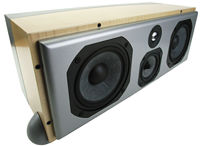Revel Performa F50 surround speaker system Page 2
The Music Goes Round and Round . . .
. . . but first I'll describe how the F50s performed alone in 2-channel stereo mode, driven full-range and without a subwoofer. This is often the preferred way to listen to non-video material for audiophiles who are also interested in home theater. They may appreciate the importance of a good subwoofer and surrounds with soundtracks, but have issues with using subwoofers for music and/or surround generated from a 2-channel stereo source. I don't necessarily agree (or disagree—it's a very complicated subject), but it was easier to get a handle on the sound quality of the left and right F50 speakers without the rest of the system fired up.
Driven in stereo, sans sub, the F50s' performance proved yet again that, while you can get subtle performance improvements as the price increases, the price/performance curve for the main speaker pair really does come close to leveling out somewhere just south of $10,000/pair. I did most of my soundtrack listening (see below) with the F50s' (and C50's) grilles in place, but I more often preferred the speakers with the grilles off when listening to music. (This also suggests that the darker cabinet options, with their black baffles, will look better in this application—the drivers will be less conspicuous with the grilles removed than on the sycamore finish with its light gray baffle.) The sound became more defined and precise. The depth improved. The bass even sounded tighter. The difference wasn't earth-shaking, but for me, the sound of the F50s on music was more compelling with the grilles removed—even if subsequent measurements failed to show anything but the subtlest of response differences.
 To a similar degree, tilting the cabinet forward a few degrees also improved the overall sound, since my ear position was several inches below the tweeter axis with the cabinet standing straight and level.
To a similar degree, tilting the cabinet forward a few degrees also improved the overall sound, since my ear position was several inches below the tweeter axis with the cabinet standing straight and level.
With everything dialed-in, the Revel F50s' 2-channel performance didn't disappoint me. Their sound was open and airy on top, uncolored in the midrange, and solid on the bottom. It was only when I switched in the B15 that I could hear what I was missing in the bass. The improvement with the subwoofer was more in clarity than in extension. Much of that clarity came courtesy of the B15's parametric equalizers, which minimized the almost inevitable bass unevenness that room modes cause. And while I had initially felt that the F50's bass sounded tighter on its own, I was convinced otherwise by long-term listening to the combination of F50s plus equalized B15.
Having said that, I doubt that those buying only a pair of F50s primarily for listening to music will feel deprived by not having also sprung for a B15. That comment also applies to film enthusiasts who rarely watch bass-heavy action movies (though you'd be surprised how a few added hertz at the bottom can add emotional weight to many films driven primarily by character and plot.) The F50s sailed through the subterranean organ pipes on Pomp and Pipes (Reference RR-58CD). The bass drums on this recording also made me sit up straight, as did the solid drum whacks that punctuate the soundtrack CD of Patriot Games (RCA 66051-2). Nothing seemed missing.
Moving on up, the F50's midrange performance gave no cause for complaint. Solo voices and instruments were reproduced without clearly identifiable colorations. Choral recordings, such as Reference Recordings' superb Postcards (RR-61CD), were detailed and precise, with individual voices as discernible as you could want.
The High Country
When I first listened to the F50s fresh out of the box, I was not happy with the overall sound. The speakers sounded noticeably bright. But they improved significantly with a few weeks' break-in, and they have since settled in to reveal almost impeccable performance through the midrange and top end. If I had any lingering reservation about the sound, it would be that I still heard a little edginess—a dryness or slight emphasis—somewhere in the upper-mid/lower-treble region. This was a rare distraction, obvious mainly with loud, complex recordings—for example, a symphony orchestra playing at full throttle—when the speakers could brighten noticeably and lose some of their normally superb resolution.
I could just as easily blame the recordings. Revel aims its considerable resources at getting a flat response free of the resonances and dynamic compression that hobble lesser speakers. But if there has been one consistent observation about the Revel sound, it's that it tends to be a little analytic and unforgiving of the recording and/or the rest of the system (including the room). I heard these same qualities in the F50, which can't be described as "sweet and tube-like." That's a plus for me, but it won't be for everyone.
The F50's overall treble response, particularly the very top end, was exceptional. This was nowhere more evident than with Sara K.'s Hobo (Chesky CHDVD177), a 2-channel, 24-bit/96kHz recording that I played back at full resolution. It sounded stunning: There was no edge to the crisply detailed guitar, the delicate brushed cymbals, or Sara K.'s airy, smoky voice. The F50s also produced an open, detailed soundstage, with excellent depth and precise image placement—even with a projection screen hovering 2 feet behind them. Here and on other material, centered voices and instruments imaged so well that it seemed as if the C50 center-channel speaker was operating. It wasn't.
- Log in or register to post comments





























































